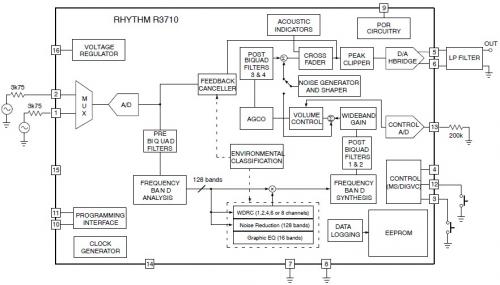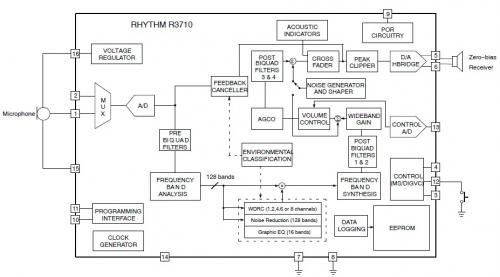Rhythm R3710预配置DSP系统实践应用指南
RHYTHM R3710信号路径
There are two inputs into the audio signal path. The first input is the front microphone and the second input can be a second microphone or telecoil input as selected by a programmable MUX. The front microphone input is intended as the main microphone audio input.

Figure 3. Test Circuit

Figure 4. Typical Application Circuit
The audio input is buffered, sampled and converted into digital form using an A/D converter. The digital output is converted into a selectable 32 kHz or 16 kHz, 20−bit digital audio signal. Further IIR filter blocks process the microphone signal. These are followed by four cascaded biquad filters: pre1, pre2, pre3 and pre4. These filters can be used for frequency response shaping before the signal goes through channel and adaptive processing.
The channel and adaptive processing consists of the following:
Frequency band analysis 1, 2, 4, 6 or 8 channel WDRC 16 frequency shaping bands (spaced linearly at 500 Hz intervals, except for first and last bands) 128 frequency band adaptive noise reduction Frequency band synthesisAfter the processing the signal goes through two more biquad filters, post1 and post2, which are followed by the AGC−O block. The AGC−O block incorporates the Wideband Gain and the Volume Control. There are also two
more biquad filters, post3 and post4, and the Peak Clipper. The last stage in the signal path is the D/A H−bridge. White noise can be shaped, attenuated and then added into the signal path at two possible locations: before the Volume Control (between the Wideband Gain and the Volume Control) or after the Volume Control (between post 4 and the Peak Clipper) as shown in Figure 1.
功能模块描述
iSceneDetect 1.0 Environment Classification
The iSceneDetect feature, when enabled, will sense the environment and automatically control the enhancement algorithms without any user involvement. It will detect speech in quiet, speech in noise, music, quiet and noise environments and make the necessary adjustments to the parameters in the audio path, such as ANR, WDRC and FBC, in order to optimize the hearing aid settings for thespecific environment.
iSceneDetect will gradually make the adjustments so the change in settings based on the environment is smooth and virtually unnoticeable. This feature will enable the hearing aid wearer to have an instrument which will work in any environment with a single memory.
Evoke Advanced Acoustic Indicators
Advanced acoustic indicators provide alerting sounds that are more complex, more pleasing and potentially more meaningful to the end user than the simple tones used on previous products. The feature is capable of providing pulsed, multi−frequency pure tones with smooth on and off transitions and also damped, multi−frequency tones that can simulate musical notes or chords.
A unique indicator sound can be assigned to each of the ten system events: memory select (A, B, C, or D), low battery warning, digital VC movement and digital VC minimum/maximum. Each sound can consist of a number of either pure tones or damped tones but not both.
A pure tone sound can consist of up to four tones, each with a separate frequency, amplitude, duration and start time. Each frequency component is smoothly faded in and out with a fade time of 64 ms. The start time indicates the beginning of the fade in. The duration includes the initial fade−in period. By manipulating the frequencies, start times, durations and amplitudes various typ
- Rhythm R3710预配置DSP混合系统重点详析(07-14)
- Rhythm R3710预配置DSP系统设计所需规范详析(07-14)
